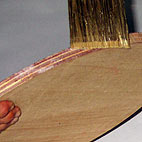Choose the right backing board
While you can basically mosaic on anything, choosing the right mosaic backing board will ensure your piece lasts much longer.
 | MDF (Medium Density Fibreboard) – Popular for craft projects due to it’s ease of use & low cost, but a poor choice for mosaic projects due to it’s vulnerability to water damage. I would’t advise using MDF for mosaic unless it’s kept inside & away from wet areas like bathrooms, but even then you run a risk due to humidity changes. |
 | Plywood – I use plywood a lot as it’s easy to cut & put screws into etc. It also is susceptible to water damage, but if sealed correctly & covered in sealed mosaic or paint, it is essentially waterproof. Always use exterior plys as they contain waterproof glues. Marine ply has no advantage over exterior ply other than a perfect face – a benefit that means nothing when you’re covering the work with mosaic. Plywood is the standard material supplied with my all-in-one mosaic kits. |
 | Concrete & Terracotta – These are both great substrates for mosaic due to their porosity and natural weather resistance. Always make sure your surface is thoroughly cleaned & use a single coat of primer to aid good glue contact. |
 | (CFC) Compressed fibre cement – One of our materials of choice when it comes to outdoor murals or tabletops. It’s advantage is total weather resistance & good rigidity, it’s disadvantages are difficulty in cutting, weight compared to other materials & of cost. It’s very unlikely you’ll get it “off the rack” in a hardware store & you’ll often have to order it by the sheet. A single coat of primer will make this material absolutely foolproof in weather, which is the reason we use it. |
… use a quality mosaic sealant
If you’re using timber or MDF, I can’t stress enough the importance of a genuinely waterproof product to seal your backing board. Many sealant products seem practical and reasonably cheap, but if they’re labelled for water resistance (not waterproofing) they’re unlikely to work in the long run – particularly if your piece is exposed to the weather or any water.
Check your labels carefully – you want a waterproof acrylic product for outdoor projects, and a water resistant acrylic product for indoors use.
There are other solvent based products that are most effective selants, but not the best base for a mosaic. If you use them, allow a long curing time – at least what is suggested on the label – that gives the solvent time to evaporate away.
Your local tile expert should be able to advise on the right product, or I have excellent acrylic sealant products available here.
…then seal it thoroughly
Sealing and/or priming your board is a very important step. It keeps moisture out of your backing board and gives your glue something to stick to. My personal rule of thumb is to overdo the sealing process (rather than cut corners).
Try to seal your board in advance of the day you want to lay tiles – waiting around for sealant to dry is no fun at all when you’re ready to get started.
Sealing instructions are for timber and MDF, if you’re using terracotta or concrete board, a single coat of sealant is sufficient – acting as a primer rather than a sealant.
 | Prepare some of your sealant in a separate margarine container or similar and brush liberally over the front, back, and edges of your board. |
 | Pay special attention to the edges and any imperfections in the plywood (this is where water is most likely to enter).Keep flooding these areas until they stop “sucking” the liquid up. |
| Three coats is sufficient for indoors use, but 4-5 coats would be better for outdoors or wet areas. Wait until the sealant dries completely before applying the next coat (30-60 minutes in average conditions) Clean your brush thoroughly & quickly before the sealant starts drying. | |

